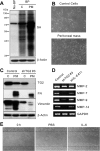Tissue transglutaminase-interleukin-6 axis facilitates peritoneal tumor spreading and metastasis of human ovarian cancer cells
- PMID: 26755922
- PMCID: PMC4707147
- DOI: 10.5625/lar.2015.31.4.188
Tissue transglutaminase-interleukin-6 axis facilitates peritoneal tumor spreading and metastasis of human ovarian cancer cells
Abstract
Inflammation has recently been implicated in cancer formation and progression. As tissue transglutaminase (TG2) has been associated with both inflammatory signaling and tumor cell behavior, we propose that TG2 may be an important link inducing interleukin-6 (IL-6)-mediated cancer cell aggressiveness, including cancer stem cell-like characteristics and distant hematogenous metastasis. We evaluated the effect of differential TG2 and IL-6 expression on in vivo distant metastasis of human ovarian cancer cells. IL-6 production in human ovarian cancer cells was dependent on their TG2 expression levels. The size and efficiency of tumor sphere formation were correlated with TG2 expression levels and were dependent on TG2-mediated IL-6 secretion in human ovarian cancer cells. Primary tumor growth and propagation in the peritoneum and distant hematogenous metastasis into the liver and lung were also dependent on TG2 and downstream IL-6 expression levels in human ovarian cancer cells. In this report, we provide evidence that TG2 is an important link in IL-6-mediated tumor cell aggressiveness, and that TG2 and downstream IL-6 could be important mediators of distant hematogenous metastasis of human ovarian cancer cells. Intervention specific to TG2 and/or downstream IL-6 in ovarian cancer cells could provide a promising means to control tumor metastasis.
Keywords: Tissue transglutaminase; human ovarian cancer; interleukin-6; metastasis.
Conflict of interest statement
Figures




Similar articles
-
Transglutaminase 2 facilitates the distant hematogenous metastasis of breast cancer by modulating interleukin-6 in cancer cells.Breast Cancer Res. 2011 Oct 3;13(5):R96. doi: 10.1186/bcr3034. Breast Cancer Res. 2011. PMID: 21967801 Free PMC article.
-
Epithelial-to-mesenchymal transition and ovarian tumor progression induced by tissue transglutaminase.Cancer Res. 2009 Dec 15;69(24):9192-201. doi: 10.1158/0008-5472.CAN-09-1257. Cancer Res. 2009. PMID: 19951993
-
IL-1β induces IL-6 production and increases invasiveness and estrogen-independent growth in a TG2-dependent manner in human breast cancer cells.BMC Cancer. 2016 Sep 8;16(1):724. doi: 10.1186/s12885-016-2746-7. BMC Cancer. 2016. PMID: 27609180 Free PMC article.
-
Tissue transglutaminase promotes or suppresses tumors depending on cell context.Anticancer Res. 2009 Jun;29(6):1909-19. Anticancer Res. 2009. PMID: 19528447 Review.
-
Transglutaminase 2: a multi-tasking protein in the complex circuitry of inflammation and cancer.Biochem Pharmacol. 2010 Dec 15;80(12):1921-9. doi: 10.1016/j.bcp.2010.06.029. Epub 2010 Jun 25. Biochem Pharmacol. 2010. PMID: 20599779 Review.
Cited by
-
Efficacy of artemether against toxocariasis in mice: parasitological and immunopathological changes in brain, liver, and lung.Pathog Glob Health. 2024 Feb;118(1):47-64. doi: 10.1080/20477724.2023.2285182. Epub 2024 Jan 2. Pathog Glob Health. 2024. PMID: 37978995 Free PMC article.
-
Effects of bisphenol compounds on the growth and epithelial mesenchymal transition of MCF-7 CV human breast cancer cells.J Biomed Res. 2017 Jul 13;31(4):358-369. doi: 10.7555/JBR.31.20160162. J Biomed Res. 2017. PMID: 28808208 Free PMC article.
-
The impact of elevated C-reactive protein level on the prognosis for oro-hypopharynx cancer patients treated with radiotherapy.Sci Rep. 2017 Dec 19;7(1):17805. doi: 10.1038/s41598-017-18233-w. Sci Rep. 2017. PMID: 29259311 Free PMC article.
-
Transglutaminase 2 takes center stage as a cancer cell survival factor and therapy target.Mol Carcinog. 2019 Jun;58(6):837-853. doi: 10.1002/mc.22986. Epub 2019 Mar 28. Mol Carcinog. 2019. PMID: 30693974 Free PMC article.
-
For robust big data analyses: a collection of 150 important pro-metastatic genes.Chin J Cancer. 2017 Jan 21;36(1):16. doi: 10.1186/s40880-016-0178-z. Chin J Cancer. 2017. PMID: 28109319 Free PMC article. Review.
References
-
- Lorand L, Graham RM. Transglutaminases: crosslinking enzymes with pleiotropic functions. Nat Rev Mol Cell Biol. 2003;4(2):140–156. - PubMed
-
- Fesus L, Piacentini M. Transglutaminase 2: an enigmatic enzyme with diverse functions. Trends Biochem Sci. 2002;27(10):534–539. - PubMed
-
- Mehta K. Biological and therapeutic significance of tissue transglutaminase in pancreatic cancer. Amino Acids. 2009;36(4):709–716. - PubMed
-
- Mehta K, Fok J, Miller FR, Koul D, Sahin AA. Prognostic significance of tissue transglutaminase in drug resistant and metastatic breast cancer. Clin Cancer Res. 2004;10(23):8068–8076. - PubMed
-
- Verma A, Mehta K. Tissue transglutaminase-mediated chemoresistance in cancer cells. Drug Resist Updat. 2007;10(4-5):144–151. - PubMed
LinkOut - more resources
Full Text Sources
Other Literature Sources
Research Materials

